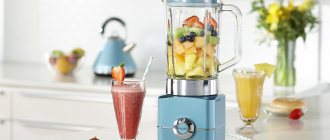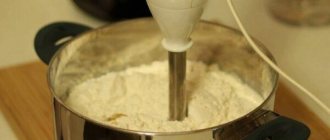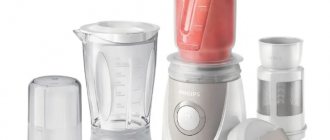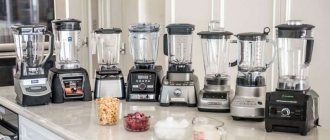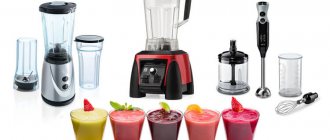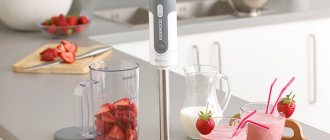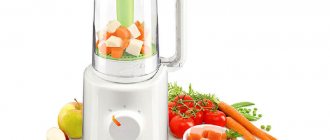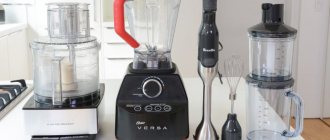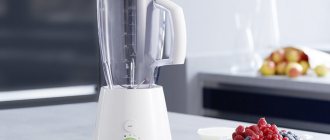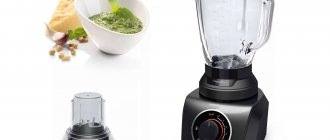What is a blender and who invented it?
The word blender comes from the English blender - to mix. This unit is one of the oldest kitchen units. Only the meat grinder is older than him (25 years).
The first such device was invented by Stephen Poplawski in 1922. The idea for this device came to him in an attempt to automate the preparation of the soda fountain drink. In the USSR, such a drink was known as “soda with syrup,” which was sold everywhere in special vending machines.
The first of these units consisted of a container on a stand. At the bottom of the bowl there was a knife similar to a propeller, which could only mix the ingredients, but not cut. In fact, this was the first prototype of a stationary blender.
It became widespread during Prohibition in the United States due to the fact that establishments began to secretly serve alcohol only in cocktails (to avoid police claims). The blender at that time allowed bartenders to automate the preparation of drinks and meet the increased demand.
A modern blender can easily replace a food processor. Its main advantage is that it is quite small-sized and easy to handle, which allows it to be used without any extra effort. With this unit you can easily chop, cut and beat ingredients for dishes.
Types of devices and their differences
Existing types of blenders:
- submersible;
- stationary.
A stationary blender is a device that consists of a technical unit and a mixing glass with knives at the bottom.
The advantage of this type of device is that, unlike an immersion blender, you do not need to constantly hold the device in your hands to grind food.
The disadvantage of a stationary blender is that you can only mix the ingredients in the bowl supplied. But it is great for making various cocktails and smoothies.
An immersion blender differs from a stationary blender in having wider functionality. The device consists of two parts: a hardware unit and an attachment, while the number and functionality of attachments may vary.
Pros of an immersion blender:
- You can grind products in any container that is resistant to mechanical stress, which allows you to work with any volume of ingredients
- A large number of attachments that expand functionality (whisk, chopper, etc.)
- It doesn't take up much space in the kitchen
Flaws:
- You must always hold the device in your hands
- Not suitable for preparing liquid foods
Blender bowls and containers can be made of plastic, glass and metal. At the same time, glass, if handled carefully, is the most durable and environmentally friendly. Nozzles are made of stainless steel or plastic.
Professional blenders are a special type of device. They have large bowl capacity, power and high reliability, but their price is much higher. Also, as you can already understand from the name, such devices can be not only for home use, but also for commercial use.
As a result, the difference between devices for grinding products lies in their different purposes. The stationary one is better at mixing and whipping liquid mixtures, and the submersible one is better at slicing and grinding harder products.
Professional devices
Premium-class blenders are designed for long-term use and active work with a large number of products. Shockproof stainless steel housing, sound insulation, bulky design - all this may be too inappropriate for an ordinary kitchen, but professional models have undoubted advantages.
Advantages of professional models
professional blenders for the kitchen are distinguished by their durability, the absence of the risk of breakage and malfunctions, and the high speed of food processing. Unlike household appliances, professional ones have different speed modes and several types of additional programs. At home, this is not always necessary , but when operating a bar or small cafe, it will certainly come in handy.
Advice: the price for professional blenders will be significantly higher than for conventional household appliances, but if there is a need for a device that will last for decades and cope with any task, you can think about purchasing it.
Useful features of blenders
Here are the most popular blender functions:
- Mixing - one of the most popular functions allows you to mix and simultaneously beat liquids and suspensions until smooth. This function is basic for stationary devices.
- Shredding and slicing - allows you to grind food to the required consistency. In some models, the duration and intensity of cutting can be controlled manually, which allows you to achieve the optimal consistency of products for each dish, from slicing to purees.
- Whipping - many hand blenders have this mode thanks to the whisk attachment. In some cases, it allows you to replace the mixer, but it is still inferior in power.
Additional features and capabilities:
- Ice crushing.
- Preparing mixtures in a vacuum environment (allows you to keep cocktails fresh longer).
- Speed adjustment and turbo mode (allows you to control the speed and intensity of the device).
- Grate food directly into the cooking bowl thanks to the grater attachment.
- Expensive models have the function of kneading dough using special hook attachments. Thanks to them, the dough is kneaded evenly and does not stick to the walls of the bowl.
What can you cook in a blender?
Using a blender you can prepare a huge number of dishes:
- puree soups;
- cocktails;
- sauces;
- salads;
- various desserts.
Here are some of the most popular dishes and the general principle of preparing puree soups.
The principle of preparing puree soups using the example of cream of mushroom soup
To prepare mushroom cream soup from champignons, you need:
- 500 grams of potatoes of any size.
- 150 grams of onion.
- 600 grams of water.
- 250 grams of mushrooms (fresh or frozen).
- 200 grams of cream 10-20% fat.
- salt (at your discretion).
First, finely chop the onion into cubes and fry in refined vegetable oil for 5 minutes at medium temperature until golden brown.
Mushrooms are cut into medium pieces (you can cut several pieces lengthwise “in the shape of a mushroom” for decoration). Chopped champignons are added to the fried onions and fried together for 7-10 minutes to enhance the taste and aroma.
Next, place a pan of water on the stove and prepare the potatoes (peeled and cut into the size of a walnut). After boiling, the potatoes are thrown into the water and cooked until tender for about 15 minutes.
Then add the onion-mushroom mixture to the pan and cook for another 5 minutes, and then grind the pieces of vegetables in the soup with a blender until pureed.
The last step is to add cream to the prepared mixture and bring to a boil, stirring. The dish is decorated with pieces of fried mushrooms and herbs.
The general principle for preparing all such soups is to grind the solid ingredients to a homogeneous puree-like mass, and the base of the soup can be anything: vegetable, as in the presented recipe, or broth.
Curd
The recipe for making curd mass is extremely simple.
To make the curd mass, you need:
- about 500 grams of cottage cheese
- 4-5 large spoons of sour cream
- salt and sugar to taste
Proportions are approximate and may vary. Also, if desired, you can add various berries and jam.
An immersion blender works best for preparing this dish. All ingredients are loaded into a bowl and ground until smooth within 2-3 minutes.
Milkshake
A stationary blender will handle a milkshake better.
The principle of its preparation is to whip milk and ice cream with various fillings. Moreover, the ratio of ingredients can be very different depending on preferences. For example, for a classic milkshake, a glass of milk and a couple of scoops of creamy ice cream will be enough.
Of course, this is not everything that can be prepared using a blender; there are hundreds of recipes using this device.
The operation of an immersion blender in cooking
Preparing dishes using an immersion blender significantly speeds up work in the kitchen. For example, if earlier, in order to cook a puree soup, you had to stand for a long time and rub the boiled products through an iron sieve, now everything is changing. A few seconds of operation of the submersible paw, and all the products are evenly crushed.
What can be prepared using a blender:
- puree and cream soups;
- cocktails and smoothies;
- homemade ice cream and sorbets;
- batter for biscuits and pancakes.
What can you grind in a blender?
You can grind many ingredients in a blender.
The most popular of them are:
- Vegetables, fruits and berries - cucumbers, tomatoes, carrots, cabbage, eggplants, zucchini, onions, pumpkin, apples, bananas, pears, etc. Almost any berries can be chopped. It is important to mention that when mashing boiled potatoes with a blender, it becomes more viscous and dense due to starch and this consistency will not be to everyone’s taste. You should also refrain from blending apples with metal attachments, since when it comes into contact with metal, the apple oxidizes and changes its taste.
- Various greens - parsley, dill, green onions.
- Nuts - peanuts, walnuts, cashews, almonds and others. At the same time, they can be ground into a paste.
- Meat - beef, pork, veal, lamb. The resulting minced meat has a slightly different, denser consistency, which makes the cooked meat more uniform, but less juicy.
- The blender can also be used as a coffee grinder - grind coffee and crush ice if you have a special grinder.
For better processing, it is recommended to pre-cut all products into pieces, and boil especially hard ones.
Homemade cocktail
What can you prepare using a blender from dairy products? Making a milkshake is more than simple. All ingredients are mixed and crushed, whipped additionally if necessary.
What products will we take:
- milk or cream of any fat content;
- creamy ice cream or ice cream;
- nuts.
Preparation:
- So, it is better to grind the nuts for the recipe in a coffee grinder, since a blender can only handle soft cashews or peanuts. But it's not worth the risk.
- Pour a third of the prepared volume of milk into a glass of a stationary blender, add ice cream and ground nuts. Whisk everything together.
- Add milk to the desired volume of the drink and beat again for a second. Nut milkshake made using a blender!
Top the drink with a scoop of ice cream and ground nuts for a cute and delicious presentation.
Many smoothie recipes using a blender include fresh or frozen fruits and berries. The basis can be milk, fermented milk product (kefir, fermented baked milk, yogurt) or juice. Additionally, you can add to the cocktail if desired:
- fresh or dried mint, basil or sorrel;
- ground nuts (using a coffee grinder);
- sesame seeds;
- poppy;
- spices - coriander, white pepper (optional).
Sugar (or its substitute), honey, and fructose work well as sweets in cocktails.
The most important rules of use
Basic Rules:
- It is forbidden to wash the base handles and motor stands under running water or immerse them in it in any way, as the liquid will damage the electronic components. To clean these parts, use a well-wrung damp cloth or a special cleaning cloth.
- If a burning smell appears during operation, turn off the device immediately.
- Do not use a faulty device; if it breaks down, take it to a qualified technician at a service center.
- The use of the blender by children and persons who do not have the skills to safely handle the device is prohibited.
- When operating the blender, do not put your fingers into the container with the device running, and also be careful when washing, as the knives are very sharp.
These operating instructions for the device should be treated with extreme caution, as failure to comply may result in injury and damage to the device.
How to use the attachments
Attachments allow you to diversify the number of functions of the blender. To change the attachment, you must first turn off the blender. Then remove the previous nozzle. And finally, just install a new one. Attachments that are common among housewives:
- whisk This assistant perfectly beats milk and eggs until fluffy. It requires careful handling. Although the whisk is metal, its rotating tip can easily be damaged if used for other purposes;
- attachment for making puree. It has very durable and sharp blades. However, you can puree foods only by boiling them first;
- chopper This attachment copes with very hard products (cheese, nuts, chocolate, onions, etc.);
- hook attachments. They are designed for kneading dough. But, as a rule, manufacturers warn that a blender will not be able to handle excessively stiff dough.
The main rule of caring for a blender is to wash it immediately after use. Dried-on food remains will be much more difficult to remove. To clean, do the following:
- Unplug the plug from the socket.
- Remove the attachment from the immersion blender. And for a stationary one, take out the bowl.
- Wash the attachments and bowl with a sponge and regular dishwashing detergent.
Never wash the housing where the motor and control panel are located. If necessary, simply wipe with a damp cloth.
Sometimes leftover contents may become tightly wrapped around the blades or get caught in the rotor. Then carefully remove them, turning the knives slightly by hand. If the residue cannot be removed, you will have to remove the upper housing and casing to remove the rotor and remove the obstructing residue.
In the case of a stationary blender, you can use this cleaning method:
- Fill the bowl about halfway with warm water.
- Add a few drops of dish soap.
- Turn blender on medium speed.
- After a couple of minutes, turn off and open the bowl. Now the dirt can be easily washed off under running tap water.
It is better to store the blender unassembled, in a dry place. Do not leave the device in the dish dryer. Otherwise, its parts may rust and the motor will become unusable.
Using a blender does not require much effort. And maintenance is not as difficult as caring for an entire food processor. When used correctly, the device can last a long time. This means that cooking will now only bring joy.
General step-by-step instructions
Instructions on how to properly use a stationary blender:
- Connect the block rack with the motor to the electrical network
- Place food in the mixing bowl without exceeding the maximum mark.
- Attach the filled bowl to the motor unit and be sure to cover it with a lid.
- Turn on the device using the required mode, following the time recommended for continuous operation (it varies for devices from different manufacturers, usually 2-3 minutes)
- After mixing, pour the resulting mixture into a container, and carefully wash the bowl and wipe dry
- Unplug the device from the outlet after use.
Instructions for the immersion blender:
- Attach the required attachment to the blender
- Connect the handle-base with the motor to the electrical network
- Place food in a scratch-resistant container
- Turn on the device using the required mode, following the time recommended for continuous operation (it varies for devices from different manufacturers, usually 2-3 minutes)
- When you are finished mixing or grinding, unplug the appliance.
- Detach the nozzle from the base handle for later washing
If you follow the correct operating mode, your blender will remain an indispensable assistant in the kitchen for a long time and will serve for many years.
Immersion blenders
The immersion blender is very compact and convenient because it has a collapsible design. Therefore, it can be simply stored in a drawer or cabinet. Thanks to this feature, you can easily take it to the dacha if necessary.
The immersion blender is very compact and convenient because it has a collapsible design.
A hand blender has many different attachments: a universal blade, a whisk, attachments for crushing ice, various graters, an attachment for pureeing and kneading dough. Some models contain 1-2 bowls in a set, although when working with an immersion blender, you can use any deep containers.
A hand blender has many different attachments: a universal blade, a whisk, attachments for crushing ice, various graters, an attachment for pureeing and kneading dough.
When using small dishes, it will not be possible to avoid splashing the product, which will lead to additional cleaning of the kitchen. Unlike a stationary one, it can chop much more food. Using this device you can prepare a huge number of different dishes: sauces, creams, jams, desserts, baby food and much more.
When using small dishes, it will not be possible to avoid splashing of the product, which will lead to additional cleaning of the kitchen.
A small disadvantage of this model is that the person working with it has his hands full. You need to hold it and at the same time press the start button with your finger. It is necessary to keep the entire work process under control. You can’t just turn it on and do something else at the same time.
A small disadvantage of this model is that the person working with it has his hands full.
See alsoFeatures of using decorative stone in the kitchen interior
Operating instructions for immersion blenders
The rules for how to use an immersion blender are identical to the rules for a stationary one. However, due to the specific design, they are still slightly different.
The rules for how to use an immersion blender are identical to the rules for a stationary one.
To use the blender you must do the following.
- Take a deep container or a special bowl.
- Place peeled and chopped products into a bowl.
- Install the attachment required for the job.
- Hold the handle in your hand and lower the blender into the container, pressing the start button with your finger.
- To complete the work, you must release the button and remove the device from the bowl.
- Unplug the device from the outlet.
- After this, you need to remove the nozzle and rinse in running water.
The upper part with the motor and controls must not be washed! If necessary, it can be wiped with a damp sponge and then wiped dry. Immersion blenders have two speeds and can additionally have a pulse or turbo mode. But these modes cannot be used for long-term operation, as this can lead to overheating of the motor. It is necessary to take breaks from work.
The upper part with the motor and controls must not be washed!
Note! If the model has smooth gear shifting, this will extend the life of the motor.
See alsoFeatures of using mirror tiles in interior design
Blender functions
How does an immersion blender work and what is useful in the kitchen? The functionality of this blender exceeds the capabilities of a stationary one. It can perform all the tasks of the previous one, and also has additional ones. You can even squeeze juice with it.
How does an immersion blender work and what is useful in the kitchen?
Hand blender attachments
- The immersion nozzle or foot is indispensable when preparing cocktails, cream soups, purees or sauces. Made of metal, it allows you to work even with hot dishes.
- The chopper attachment is necessary when preparing minced meat, minced meat, chopping cheese, nuts, herbs or fruits. Choppers are divided into compact (0.3 liters), medium (0.5 liters), large (1 liter). Some blenders come with two included.
- To make cocktails you will need an ice knife. This is a special knife with serrated blades.
- The whisk is used for preparing: dough, cream, beating eggs, cream, cream.
- A food processor bowl with an attachment for chopping and slicing food or a knife for chopping. The bowl can hold a fairly large amount of food, its volume is 1.5-2 liters.
- Attachment for cutting food into cubes. Bowl volume – 2 liters. The set is completed with attachments for shredding and slicing.
- The Brown “mashed potato” blender attachment will prepare the most delicate mashed potatoes in a matter of seconds. A regular immersion attachment will turn the puree into an unpleasant paste.
- Some Bosch models have attachments for frothing milk or preparing mayonnaise.
See alsoFeatures of using green wallpaper to decorate the interior of your home
Safety precautions
When working with the device, you must not only know how to assemble the blender correctly, but also follow the safety rules according to the instructions in order to avoid accidental injury. We should not forget that the work is carried out with sharp objects. After finishing work, the blender must be unplugged from the outlet and only then can you remove the knives or attachments.
When working with the device, you must not only know how to properly assemble the blender, but also follow the safety rules according to the instructions
What not to do
- Do not knead dough that is too stiff.
- Long-term continuous work is contraindicated.
- Do not abuse turbo mode.
- Grind hard and large products whole.
- When grinding foods with low liquid content, be sure to add a small amount of water.
- Do not put the blender foot into boiling water.
See alsoFeatures of using orange color and its combinations in the interior of rooms
What to cook with a blender and its attachments
Using a blender, you can prepare a huge number of delicious desserts: for example, ice cream with additives in the form of berries or pieces of fruit, and you can complete the composition with chopped chocolate.
Using a blender you can prepare a huge number of delicious desserts: for example, ice cream
It will do a great job of making dough for pancakes or pies. Quickly and beautifully cuts or chops vegetables for stews or salads. In a word, he is simply an indispensable assistant in the kitchen.
It will do a great job of making dough for pancakes or pies.
See alsoFeatures of washing and cleaning electric stoves
Blender Care
Caring for the blender is quite simple. The main rule is to wash all knives, attachments and bowls immediately after finishing work.
Caring for the blender is quite simple.
To clean the blender buttons, you will need a wet, soapy toothbrush. Do not wash or wet parts containing electrical parts. To prevent the seal from drying out, you can lubricate it with vegetable oil.
Do not wash or wet parts containing electrical parts.
The blender must be stored in a dry place and unplugged from the outlet after use.
See also Niche under the kitchen window: advantages and disadvantages, use cases
